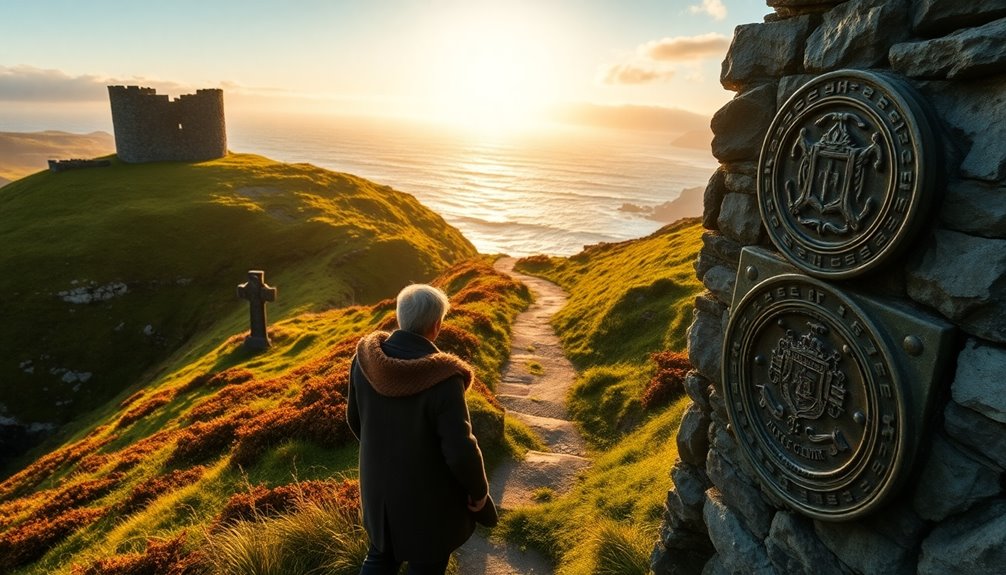
When exploring Irish heritage, plan visits around festivals and book key events early so you won’t miss highlights. Move gently through parades and music sessions: listen first, ask before joining, and let locals lead. Visit heritage centres, cairns, and workshops with curiosity and consent, support artisans, and consider volunteering to get deeper access. Pack for changeable weather and bring a notepad for stories. Keep an open heart and patience, and you’ll find richer layers as you continue.
Highlights
- Plan visits around heritage festivals and guided tours to access curated stories, local experts, and timely events.
- Visit heritage centres, forts, and museums for contextual exhibits and archival materials that illuminate local history.
- Attend storytelling sessions and traditional music nights to experience oral history and cultural continuity firsthand.
- Engage respectfully: ask permission before photographing people or sacred sites, and follow site-specific rules.
- Support local craftspeople and workshops to preserve traditions and gain authentic, place-based souvenirs and skills.
Planning Your Visit Around Irish Festivals
When should you time your trip to Ireland to catch its most vibrant moments? You’ll want to map dates around festival highlights like St. Patrick’s Day, Galway Arts Festival, and local harvest fairs. Choose events that match your mood—music and dance for communal joy, literary gatherings for quiet discovery—to honor their cultural significance. Travel light, stay flexible, and book key shows early; small towns fill fast. Engage respectfully with rituals, support local vendors, and let spontaneous street performances guide you. That freedom lets you shape an authentic itinerary that celebrates Ireland’s living traditions without feeling constrained.
Navigating Local Parade Etiquette
How should you position yourself in a crowded street so you’ll both see the action and show respect for participants? Stand slightly back from the kerb, leave clear sightlines for others, and avoid blocking performers or instruments. Observe parade traditions: remove hats for solemn moments, applaud appropriately, and follow marshals’ directions. Mind crowd behavior—don’t push forward, keep pathways clear for emergency access, and step aside for moving floats. Take photos discreetly and limit flash. Engage with warmth but let locals lead celebrations; your freedom to enjoy comes with responsibility to protect space, safety, and the integrity of the event.
Finding Authentic Traditional Music Sessions
After you’ve soaked up parade atmosphere and learned to respect local customs, look for traditional music sessions to hear Ireland’s living heritage up close. You’ll find sessions in pubs, community halls, or tucked-away rooms; ask locals or check posters and social feeds. Listen first, then join when invited — session etiquette matters: wait for a gap, introduce yourself briefly, and don’t dominate. Appreciate traditional instruments like fiddle, uilleann pipes, concertina, bodhrán, and flute; their interplay is conversational. Let the music move you freely, respect players and space, and you’ll leave with memory and connection rather than just a souvenir.
Tips for Joining Community Dance Events
If you want to join a community dance event, remember that these gatherings are as much about connection as they are about steps—so come ready to listen, watch, and participate with a respectful, open attitude. You’ll blend into a living tradition if you arrive early, dress comfortably, and offer a friendly greeting. Observe patterns, ask permission before joining circles, and follow cues rather than forcing moves. Bring curiosity, not judgment; applause and small contributions help sustain cultural expression. If a caller guides the set, listen closely. Leave space for experienced dancers, learn patiently, and enjoy the shared rhythm.
Exploring Historical Sites and Heritage Centres
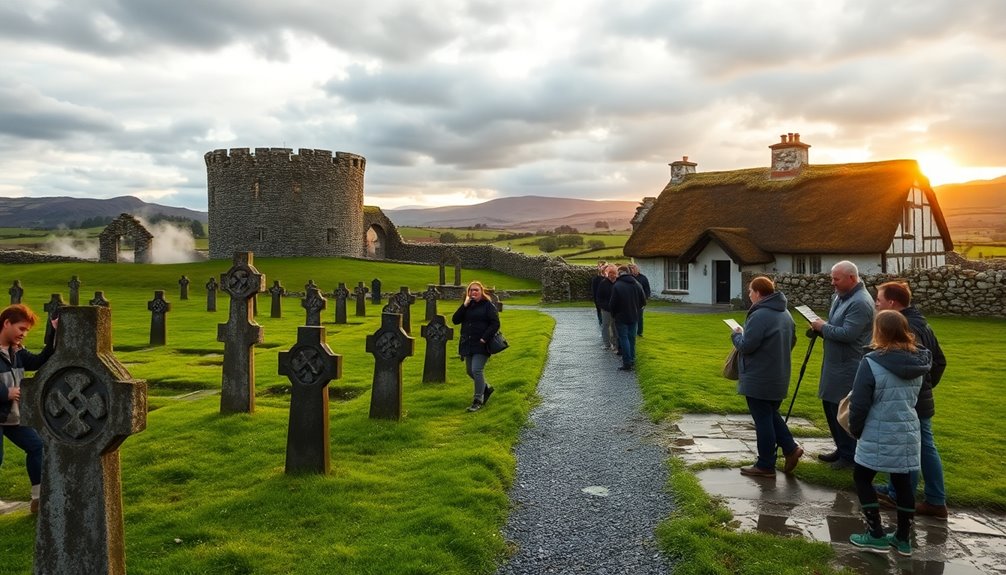
Moving from the lively warmth of a ceilí to the quieter rhythms of place, exploring Ireland’s historical sites and heritage centres lets you trace the stories behind those dances, songs, and community rituals. You’ll follow heritage trails that link villages, forts, and museums, choosing your pace and discoveries. Inherit voices rise in guided tours, displays, and quiet interpretive panels, revealing farmsteads, monastic settlements, and ancient ruins set in wild landscapes. Respectful caretakers welcome curious minds; archival rooms let you touch documents and photos. Embrace solitude or shared exploration—these places give you context, freedom, and a deeper sense of belonging.
Engaging With Gaelic Sports and Clubs
You can join a local GAA club to meet people and experience community life firsthand. Try hurling or camogie — the pace, skill and tradition make them unforgettable introductions to Irish sporting culture. Clubs are welcoming to beginners, so you’ll get coaching and a chance to play at your own pace.
Join Local GAA Clubs
Anyone curious about Irish culture will find joining a local GAA club is one of the most direct ways to immerse yourself in community life—these clubs aren’t just about hurling and Gaelic football, they’re social hubs where language, music, and local traditions thrive alongside sport. You’ll be welcomed into community engagement that’s genuine, where sportsmanship values guide play and respect. Get involved as a player, supporter, or volunteer; you’ll learn local stories, practice Irish, and share sessions that blend joy with tradition. Clubs let you move freely, contribute your skills, and build friendships rooted in common purpose and pride.
Try Hurling and Camogie
Since hurling and camogie are at the heart of many communities, stepping onto the pitch gives you a vivid, hands-on way to experience Irish culture. You’ll learn basic hurling techniques—striking, soloing, blocking—while coaches respect safety and tradition. Camogie rules differ slightly; players wear helmets and play with women’s-specific regulations, yet spirit and pace match. Join a local session, watch a match, then try drills at your own pace. You’ll feel welcome, challenged, and free to explore skills. Embrace the camaraderie, ask questions, and let the games open a lively gateway into community life.
Sampling Regional Food at Cultural Markets
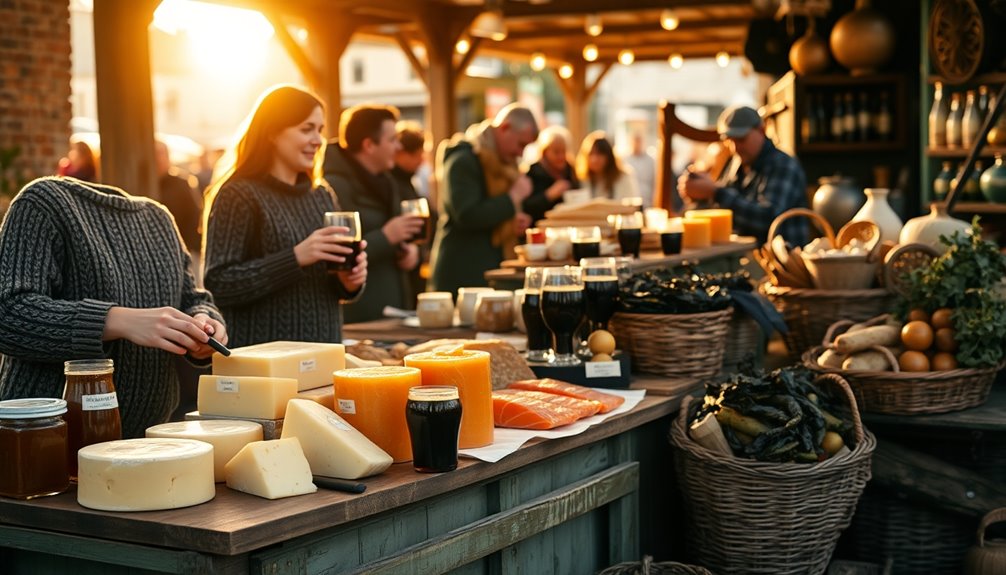
When you wander through a cultural market, you’ll find regional specialties—from Galway oysters to Kerry lamb—waiting to be tasted. Seasonal stalls spotlight fresh produce and artisanal preserves that tell the story of the land and the time of year. Talk with the producers themselves to learn their methods and the heritage behind each bite.
Local Specialties to Try
A visit to a local cultural market is the best way to taste Ireland’s regional identity—here you’ll find everything from buttery Kerry lamb and smoky Connemara seafood to soda breads still warm from the oven, each stall offering a small story about place and people. Wander, sample seafood delicacies and artisan cheeses, and talk to producers who’ll proudly explain methods and origins. Try simple treats: black pudding, boxty, and cured salmon, pairing textures and histories. You’ll leave with recommended recipes, a wrapped bite to enjoy later, and a sense that tasting here means honoring craft, land, and freedom.
Seasonal Produce Highlights
Although seasons shift quickly in Ireland, the market stalls keep you grounded in place and time: you’ll find spring’s tender lamb and wild garlic, summer’s strawberries and scallops, autumn’s root vegetables and game, and winter’s hardy brassicas and cured meats. You’ll wander farmers markets tasting freshness, imagining seasonal recipes that honor each ingredient. Pick fruit at peak, buy leafy greens still cool with morning, and note textures for simple cooking back where you stay. This approach lets you travel freely, connecting taste to landscape without fuss. Keep your choices local and seasonal, and your meals will tell the region’s story.
Meeting Producers Directly
You’ll find that stepping into a bustling Irish market is as much about the people as the produce: farmers, fishers, cheesemakers, and foragers are ready to talk seasonality, craft, and provenance as they offer tastes. You’ll meet local farmers who’ll explain soil, weather and recipe origins while you sample artisan products—smoked salmon, farmhouse cheese, soda bread. Ask about grazing, catch methods, or berry foraging; they’ll share stories and suggestions for enjoying what you buy. Buy modestly, taste widely, and let conversations guide your discoveries—you’ll leave with food, knowledge, and an invitation to return.
Participating in Storytelling and Literary Readings
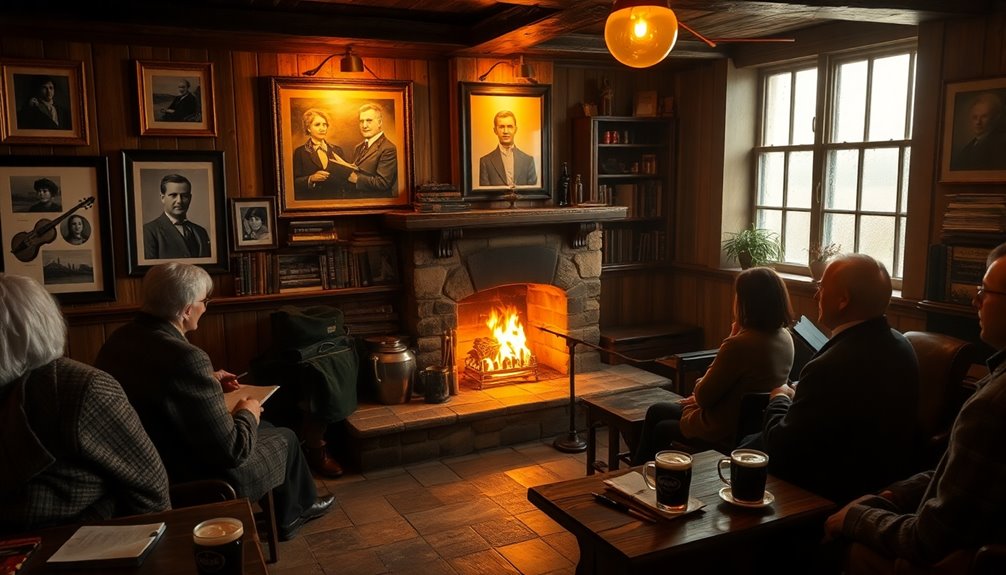
When you step into a circle for storytelling or take the mic at a literary reading, you’re entering a long Irish tradition where voice, memory, and music blend to keep history alive; expect the room to feel intimate, attentive, and charged with the quiet ritual of shared story. You’ll learn storytelling techniques that honour cadence and silence, shaping tales that travel between past and present. Listen for literary influences in language and theme, from mythic echoes to modern lyricism. Participate with openness, respect others’ turns, and let your voice roam freely while sustaining communal attention and kinship.
Volunteer Opportunities at Cultural Events
You can find volunteer roles at festivals, museums, and community centers by checking event websites, local cultural organizations, and social media groups. Before you sign up, make sure you understand the responsibilities, time commitments, and any training or background checks required. Preparing thoughtfully—learning basic event tasks, familiarizing yourself with Irish customs, and bringing appropriate clothing and supplies—will help you contribute with confidence and respect.
Finding Volunteer Roles
Although it can feel intimidating to step into a new cultural scene, volunteering at Irish festivals, céilís, or heritage days is one of the quickest ways to connect with traditions and people, learn behind-the-scenes logistics, and make a tangible contribution. You’ll find roles by checking festival websites, social media groups, local cultural centers, and parish bulletins. Prioritize positions that match your skills and desire for autonomy. Thoughtful community engagement shows respect and opens doors; fill out volunteer applications promptly and follow up personally. Expect clear expectations, modest commitments, and chances to learn while sharing your energy and curiosity.
Preparing for Events
Having secured a volunteer spot, it’s time to get ready so you can contribute confidently and respectfully at Irish events. You’ll want practical event attire that honors tradition without sacrificing comfort—think layers, tasteful colors, and sturdy shoes. Learn basic customs and a few greetings; that knowledge frees you to engage genuinely. Bring a small kit: water, notepad, and badge holder. Arrive early to meet organizers and observe flow; event networking happens naturally when you’re present and helpful. Stay curious, listen more than you speak, and let your service deepen your connection to community and culture.
Respectful Photography and Recording Practices
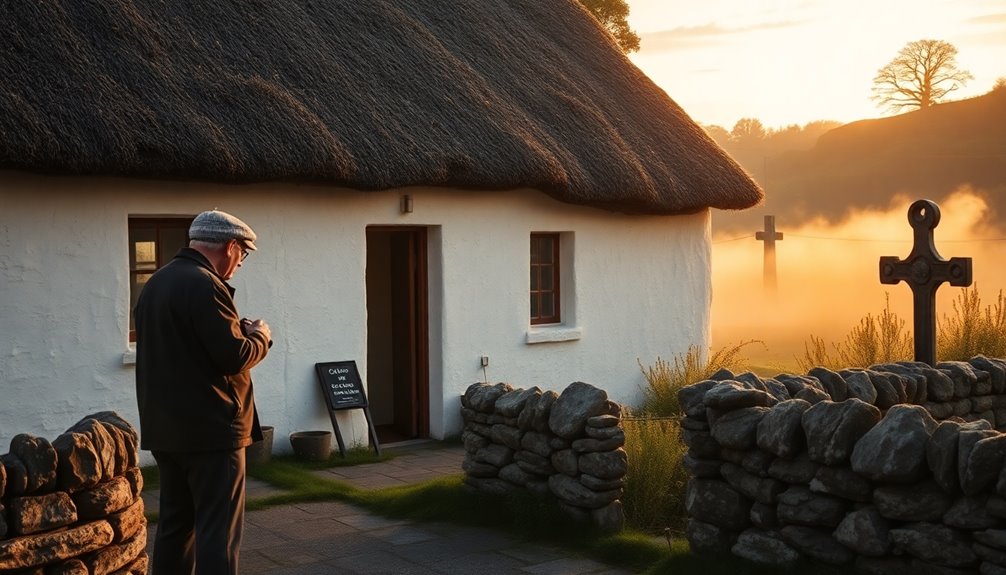
When visiting sites of Irish heritage, remember that your camera is a guest: aim to capture stories without disrupting the living traditions, private spaces, or solemn moments. You should ask before photographing people, especially during ceremonies or in homes, and follow posted rules at museums and monuments. Practice cultural sensitivity by learning what’s sacred or private, and favor quiet, unobtrusive angles. Use recordings sparingly, explain your intent, and share copies if appropriate. Frame images for ethical storytelling rather than spectacle, honoring context and consent. That way you preserve memories while respecting community autonomy and spirit.
Connecting With Local Craftspeople and Workshops
Respecting people and places also opens the door to meaningful encounters with local craftspeople and their workshops. You’ll find quieter studios where makers welcome curious questions, share techniques, and invite you to handle textures and tools. Buy handmade souvenirs thoughtfully, supporting livelihoods and preserving traditions rather than mass-produced trinkets. If you’re interested, propose artisan collaborations — a small project or commission can deepen connection and create something uniquely yours. Be punctual, polite, and flexible; many artisans balance custom work with daily routines. Leave with stories, care for your pieces, and the freedom to return or recommend these treasured makers.
Preparing for Weather and Travel Logistics
Because Ireland’s weather can shift from sun to shower within an hour, you’ll want to pack layers, a good waterproof, and sturdy footwear that handles wet cobbles and muddy paths, while keeping a light daypack for essentials like a compact umbrella, a refillable water bottle, and a power bank. Plan travel routes with flexibility — trains, local buses, and car hires can free you to wander. Check forecasts daily, but expect surprises; trust durable weather gear and quick-dry clothing. Leave room for spontaneous detours to ruins or pubs, and carry maps, tickets, and backup charging so nothing grounds your roaming spirit.
Some Questions Answered
How Can I Trace My Irish Ancestry Remotely?
You can trace your Irish ancestry remotely by starting with genealogical research using online databases like General Register Office, IrishGenealogy, and subscription services. You’ll gather civil records, church registers, and census fragments, then connect DNA results to living relatives. Respect privacy, verify sources, and explore local newspapers and emigration lists. Stay curious and persistent; freedom in discovery comes from combining documents, DNA matches, and historical context to build a meaningful family story.
Are There Beginner-Friendly Irish Language Resources Online?
Imagine a green thread unfurling into conversation—you’ll find beginner-friendly Irish language resources online. You can use online courses like FutureLearn or Oideas Gael for structured lessons, and language apps such as Duolingo or Memrise for daily practice. They’re designed to be welcoming and flexible, so you’ll progress at your own pace. Expect audio, grammar tips, and cultural notes that’ll help you speak, understand, and feel connected to Irish freely.
What Are Common Irish Superstitions or Folklore to Know?
You’ll hear warnings about fairy forts, respect for Celtic symbols, and tales of banshees predicting death; Irish legends mix reverence and caution. You’ll avoid disturbing ringforts, leave food for fairies, and honor crossroads rituals. Superstitions about salt, knocking on wood, and unlucky Wednesdays persist. These beliefs’re woven into culture respectfully, inviting you to explore with curiosity, freedom, and care for the stories and sites they protect.
How Can I Attend a Private Ceilidh or House Party Respectfully?
Sure — just sneak in like a polite fox: ask hosts beforehand, RSVP, and don’t crash a private ceilidh or house party uninvited. Respect ceilidh etiquette: tidy shoes, join dances when invited, follow callers, and ask before filming. Observe party customs: bring a small gift or contribute food, offer to help, and leave when guests thin. Be courteous, listen, step back when needed, and enjoy the music and company.
Are There Disability-Accessible Heritage Sites and Events?
Yes — many sites and events offer accessible tours and accommodations, and heritage festivals often include ramps, hearing loops, and quiet spaces. You’ll want to check accessibility info online or call ahead to confirm specifics like step-free routes, tactile exhibits, or sign-language guides. Don’t hesitate to request adjustments; organizers usually want everyone to enjoy the experience. That freedom to explore respectfully is increasingly supported across museums, castles, and festival venues.
Summing Everything Up
You’ll plan your trip around a festival’s pulse, feel the hush before a parade winds through stone streets, and slip into a snug pub where a fiddle’s first bow makes the room hold its breath. You’ll join dancers’ feet and volunteer hands, trace centuries in heritage centres, and meet craftspeople shaping memory from wood and wool. Respectful, curious, prepared for weather and wonder—you’ll leave with more questions than answers, and a longing to return.
